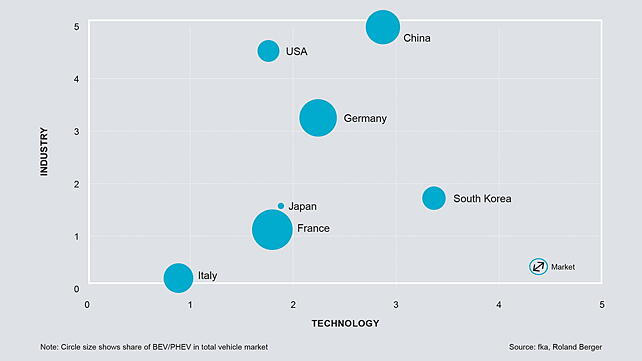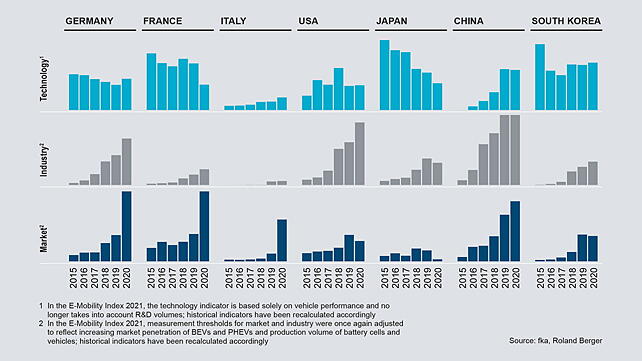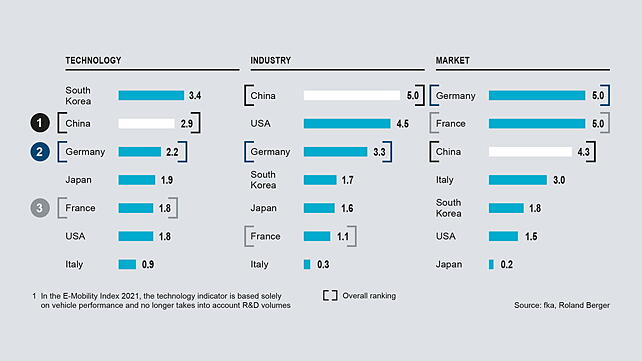
The 10th E-Mobility Index, produced by management consultancy Roland Berger in cooperation with fka GmbH Aachen, has reported China to be the leading market for EVs in the world. The country produced the largest number of electric vehicles and battery cells as per the 2021 index.
The study, conducted among seven leading automotive nations – Germany, France, Italy, the United States, Japan, China and South Korea – found Germany to have strengthened its position, while the USA experienced minor growth in the survey period.

The index assesses the performance of these countries along three key parameters: technology, industry and market. The 2021 index investigates the impact of COVID-19 on the electric mobility industry and looks at possible future developments in CO2 compliance and European emission standards.
Helped by an increase in EV sales by over 250%, Germany climbed from fifth place to the top spot in the market category. In the technology parameter, South Korea took the top spot owing to its constantly improving vehicle performance.
Sharp EV Rise In Germany
In 2020, despite being hit by the COVID-19 pandemic, Germany sold nearly 400,000 electric vehicles – a whopping jump of over 250% from the previous year’s 112,000 units. This shot the share of electric vehicles in the overall German market to 12.6% from 2.9% in 2019. Germany is now the world’s second largest market for electric vehicles, behind China.
Two other European markets – France and Italy – experienced similar high growth in EV sales. A total of 194,000 electric vehicles were sold in France last year as compared to 69,000 units of electric vehicles in 2019 – a jump of 181%. Similarly, Italy saw EV sales increase to 61,000 units in 2020 from the low base of 18,000 in 2019, thus resulting in a 238% jump.
Roland Berger attributed such positive development of e-mobility in Europe to government support for electric vehicles in the form of purchase bonuses. In Germany, for example, public authorities and manufacturers subsidise the purchase of fully electric vehicles by up to €9,000, and plug-in hybrids by up to €6,750.
According to the authors of the 'E-Mobility Index 2021' study, the German automotive industry should, for the most part, be able to meet the ambitious CO2 targets set by policymakers.

The study shows that the global situation is more disparate. Japan, for example, recorded a slump in electric car sales in 2020, while the market for electric vehicles in China and the United States grew moderately, reported Roland Berger and its partner fka GmbH.
Supply Of EV Grows
In Germany, 15 fully electric vehicles and 20 plug-in hybrids were launched in 2020, and there are an additional 14 fully electric vehicles lined up for launch this year. The USA, on the other hand, is expected to introduce 20 all-electric models in 2021, while China and France each plan to introduce 11 fully electric models this year.
Production capacities for electric vehicles were also enhanced across the surveyed markets in 2020. Despite this increase in vehicle production, public demand for electric cars could not always be met, the index observed. Waiting times of up to one year and delivery stoppages for certain vehicles prevented e-mobility from growing at an even faster rate.
Stricter Climate Targets A Challenge
The authors of the study presume that the overall positive market development will enable European automotive manufacturers to meet the average fleet emissions target of 95 g CO2/km. All newly registered vehicles in the EU from 2021 must comply with this target.
However, three developments relating to e-mobility pose challenges for the automotive industry, the study notes:
- The EU Commission wants to further adjust climate targets for vehicles. Accordingly, newly registered vehicles should emit an average of 50% less CO2 in 2030. Previously, new vehicles were expected to emit 37.5% less CO2;
- Studies on plug-in hybrids found that most markets’ real consumption rates are two to four times higher than in the laboratory. As a result, politicians and climate groups are increasingly calling for a reduction in tax incentives for plug-in hybrids compared to electric vehicles;
- In the future, regulatory authorities will pay more attention to the lifecycle assessment of a car. This means that on top of emissions during use, emissions arising further upstream – in the extraction of raw materials or the production of vehicles – will also play a role. Since car manufacturers only account for around 10-20% of production emissions, all suppliers in the value chain will be obliged to improve their carbon footprint in electric vehicle production.
Taking The Lead In Technology
In the latest index, South Korea dislodged Germany in terms of technology. South Korean automotive OEMs continue to improve the technology that they use in existing models, rather than introducing new models.

The average performance of South Korean vehicles has improved, with vehicle prices edging up correspondingly. However, the country has also introduced some new PHEVs in the SUV segment. Owing to the greater weight of such vehicles, average efficiency (measured as the range/battery capacity ratio) has decreased slightly. Nevertheless, South Korean OEMs still offer a very good price-performance ratio in their vehicles, said the report.
“China continues to improve the level of its technology, remaining in second place in terms of this indicator. Chinese manufacturers are constantly enhancing the range, efficiency and safety of their xEVs. Vehicle prices are also increasing, but they remain the lowest of any of the countries examined,” the report stated.
Key Takeaways
- Overall, China retains its competitive lead for the second year in a row. The USA dropped to the fourth position, from being second last year. Germany and France were placed second and third respectively;
- While COVID-19 has had a negative impact on vehicle markets around the world, sales of electric vehicles (xEVs) have grown strongly, especially in Europe;
- Increased sales volumes in Europe are to a large extent due to the purchase incentives contained in stimulus packages;
- Thanks to increased penetration rates for xEVs, vehicle manufacturers (OEMs) now have a realistic chance of meeting the European emission targets for 2021;
- The EU Commission is considering tightening emission limits for new vehicles by 2030;
- OEMs and suppliers must prepare themselves for additional regulation in the area of real consumption data and emissions across the entire vehicle lifecycle.